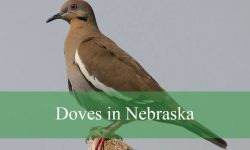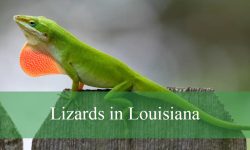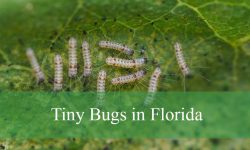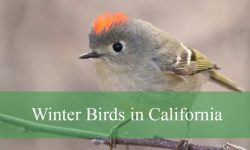On a warm summer morning in Delaware, a humming sound often gives away the presence of a tiny bird. A quick flash of green or red follows, and suddenly a hummingbird appears, hovering near a flower before darting away. These small moments make watching hummingbirds unforgettable.
Delaware is a great place to see them because the state sits along an important migration route. The Ruby-throated Hummingbird is the most common here, but other species sometimes pass through during migration. Even a simple backyard with flowers or a feeder can become a place to spot these little jewels.
Hummingbirds bring energy and beauty wherever they go. Males shine with bright colors in the sunlight, while females work carefully to build tiny nests. They can be seen in gardens, parks, and natural areas across Delaware, each sighting adding a touch of wonder to the landscape.
Types of Hummingbirds Found in Delaware
Ruby-throated Hummingbird (Archilochus colubris)
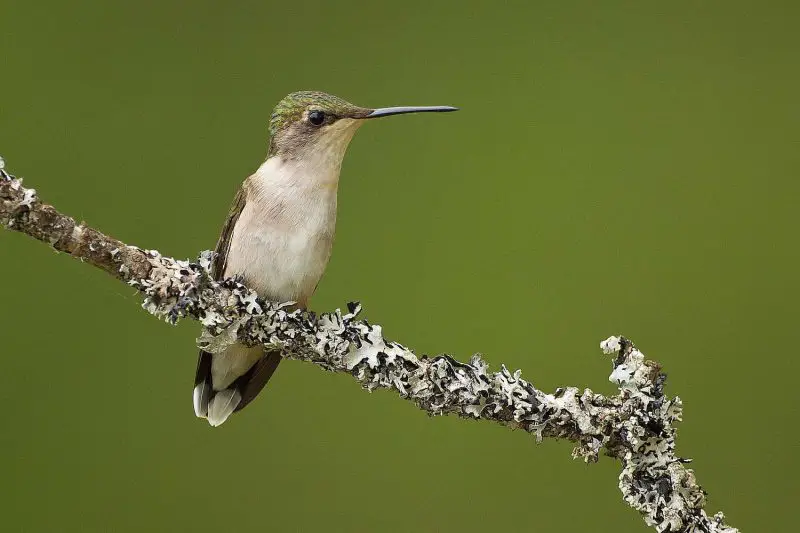
The Ruby-throated Hummingbird is the most common and widespread hummingbird in Delaware, serving as the only species that regularly breeds in the state. Adults are tiny, measuring about 3 to 3.5 inches in length with a wingspan of 3 to 4 inches. Males are instantly recognizable by their iridescent ruby-red throats that shimmer in the sunlight, contrasting with their metallic green backs and grayish underparts. Females lack the ruby throat, instead showing a white or lightly streaked throat with green upperparts. Both sexes have long, slender bills designed perfectly for probing flowers and sipping nectar.
These birds thrive in a wide range of habitats across Delaware, from suburban backyards and gardens to wooded edges and meadows filled with flowering plants. During the breeding season, males can often be seen performing their signature U-shaped courtship dives, flying back and forth to impress females. Nests are usually built by the female alone, who uses plant down, spider silk, and lichens to create a camouflaged cup-shaped nest on tree branches. A clutch typically contains two tiny white eggs, which she incubates without assistance from the male.
Feeding is a near-constant activity for Ruby-throated Hummingbirds due to their high metabolism. They primarily consume nectar from tubular flowers such as trumpet creepers, bee balm, and columbine, but they also rely on insects like gnats, mosquitoes, and small spiders for protein. In Delaware, homeowners often set up sugar-water feeders to attract these hummingbirds, and the birds quickly learn to return to reliable food sources. Their rapid wingbeats, reaching up to 53 beats per second, allow them to hover in place while feeding, a trait that fascinates birdwatchers.
A fun fact about Ruby-throated Hummingbirds in Delaware is their incredible migration journey. Despite their delicate size, many individuals migrate nonstop across the Gulf of Mexico, traveling nearly 500 miles in a single flight. Delaware serves as an important stopover during both spring and fall migrations, making gardens with feeders and flowering plants critical resting and refueling stations for these tiny travelers.
Rufous Hummingbird (Selasphorus rufus)
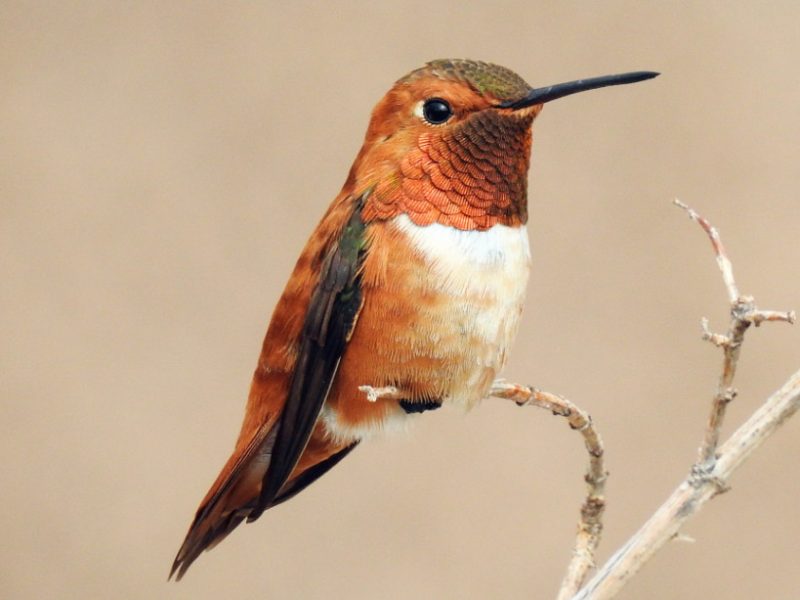
The Rufous Hummingbird is not a common breeder in Delaware but is seen as a regular migrant and occasional visitor during spring and fall. Measuring about 3.5 inches in length, males are unmistakable with their bright coppery-orange plumage, iridescent orange-red throats, and white chests. Females and juveniles are greener overall, with rufous coloring on the flanks and base of the tail. Their aggressive behavior makes them easy to identify at feeders, as they often chase away other hummingbirds—even those much larger than themselves.
In Delaware, Rufous Hummingbirds are typically observed during migration periods when they travel between their breeding grounds in the northwestern United States and Alaska to wintering sites in Mexico. They can appear in backyards, coastal areas, and even wooded landscapes, where they stop to feed and regain strength. Some individuals occasionally linger into the late fall or early winter, taking advantage of warm spells and backyard feeders that remain stocked. Their adaptability has earned them a reputation as one of the hardiest hummingbird species in North America.
Rufous Hummingbirds feed on nectar from a wide range of flowers, favoring bright red or orange blossoms that provide high energy rewards. Like Ruby-throats, they also consume small insects and spiders to meet their protein needs. Their territorial nature is especially pronounced in Delaware when multiple hummingbirds converge at a single feeder. Observers often note their relentless chasing behavior, with males defending a feeder as though it were their personal kingdom. This determination helps ensure their survival during long migrations.
A fascinating fact about Rufous Hummingbirds in Delaware is their extraordinary migration route. These tiny birds complete one of the longest migrations relative to body size of any bird species, traveling up to 3,900 miles one way. Delaware sightings are always exciting because they represent a rare glimpse of this species outside its usual range. For many birdwatchers in the state, spotting a Rufous Hummingbird is a memorable event, often considered a highlight of the migration season.
Black-chinned Hummingbird (Archilochus alexandri)

The Black-chinned Hummingbird is a rare vagrant in Delaware, with sightings occurring only occasionally. Adults measure about 3.25 inches in length with a wingspan of 4.25 inches, making them very similar in size to Ruby-throated Hummingbirds. Males are best identified by their glossy black throat, which shines with a thin band of iridescent violet at certain angles of light. Females are more difficult to distinguish, showing pale underparts and a lack of throat coloring. Their relatively straight bill and muted greenish back help birders separate them from other species.
In their normal range, Black-chinned Hummingbirds inhabit the western United States, but in Delaware, they appear as wanderers during migration seasons. They are most often reported at backyard feeders where they briefly stop before moving on. Because their appearance overlaps with Ruby-throated females, careful observation or photographic evidence is usually needed to confirm their presence in the state. These rare visits bring excitement to local birding communities, as the species is not typically expected on the East Coast.
Behaviorally, Black-chinned Hummingbirds are versatile foragers, feeding from both natural flowers and artificial feeders. They consume nectar from a variety of blooms but also rely heavily on tiny insects caught in mid-air or plucked from spider webs. Their flight is less aggressive compared to Rufous Hummingbirds, though males still defend territories during the breeding season. In Delaware, individuals that appear often integrate quietly with Ruby-throats, only standing out when their unique throat color is spotted.
A fun fact about Black-chinned Hummingbirds is their ability to thrive in both urban and natural settings. In Delaware, their rare appearances often occur in suburban gardens where feeders provide easy energy sources. Birders lucky enough to document them contribute valuable data to migration records, helping scientists understand how far these western hummingbirds can wander eastward. Every confirmed sighting in the state adds to the mystery and wonder of hummingbird migration patterns.
Allen’s Hummingbird (Selasphorus sasin)

Allen’s Hummingbird is another rare visitor to Delaware, usually appearing as a vagrant during fall migration. Very similar in appearance to Rufous Hummingbirds, Allen’s are slightly smaller at about 3.5 inches long. Males have a bright green back, rufous flanks, and an iridescent orange-red throat, while females and immature birds are mostly green with rufous patches on their sides and tail. Distinguishing them from Rufous Hummingbirds often requires close observation of tail feather patterns, which is why confirmed sightings in Delaware are so rare and celebrated.
This species normally breeds along the Pacific Coast, from southern Oregon down through California, favoring coastal scrub, chaparral, and gardens. When they appear in Delaware, it is usually during unusual weather patterns or migration mishaps that push them far outside their typical range. Birders often rely on photographs and expert identification to confirm these rare occurrences, as female Allen’s and Rufous Hummingbirds can be nearly indistinguishable in the field.
Allen’s Hummingbirds are known for their energetic behavior, feeding aggressively on nectar and insects to sustain their rapid metabolism. Males perform dramatic courtship displays by flying in steep pendulum-like dives to impress females. In Delaware, these behaviors are rarely observed since the species does not breed in the state, but feeders and late-blooming flowers sometimes provide short-term nourishment for wandering individuals. Their unexpected presence always draws attention from hummingbird enthusiasts eager for a glimpse of this western jewel.
A fun fact about Allen’s Hummingbirds in Delaware is how important documentation has become. Because of their rarity, every confirmed sighting adds to our understanding of how hummingbirds occasionally stray across the continent. Birdwatchers in the state often keep cameras handy during migration season, knowing that a brief visit from an Allen’s Hummingbird could provide a once-in-a-lifetime opportunity to capture evidence of this species so far from its normal range.
Buff-bellied Hummingbird (Amazilia yucatanensis)
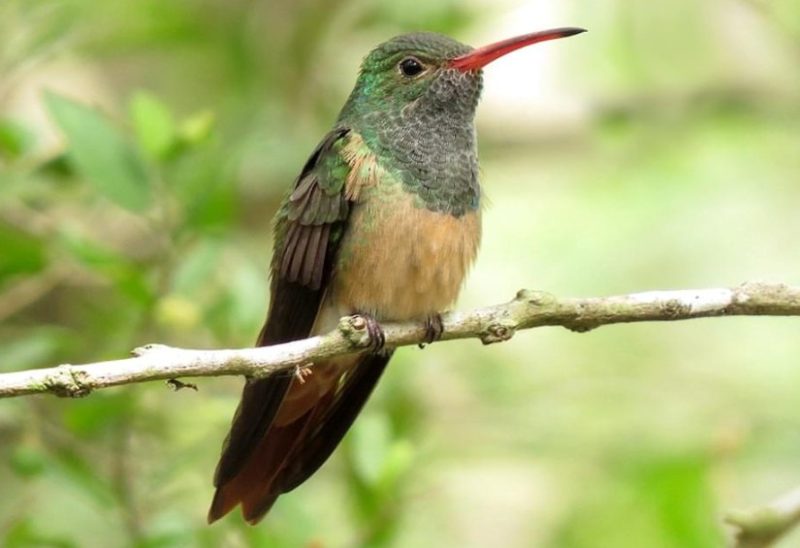
The Buff-bellied Hummingbird is one of the rarest hummingbird visitors to Delaware, as its typical range extends from southern Texas through Mexico and into Central America. Adults measure about 3.9 to 4.3 inches in length, making them slightly larger than most other hummingbirds found in North America. Their plumage is striking, with a metallic green head and back, buff-orange underparts, and a slightly curved red bill tipped with black. Males often display a subtle iridescent purple or red throat patch, which glimmers in the right light.
In their natural range, Buff-bellied Hummingbirds prefer semi-open habitats such as scrublands, coastal woodlands, and gardens. When they stray as vagrants to Delaware, they are most often found in suburban backyards where feeders are maintained. Their appearance in the state is typically linked to unusual weather patterns during migration seasons, pushing them far beyond their expected distribution. Such occurrences are exceptionally rare, making Delaware sightings treasured among birdwatchers.
Feeding behavior is similar to that of other hummingbirds: nectar is their main energy source, supplemented with small insects and spiders for protein. Their slightly larger size allows them to dominate feeders more easily than the smaller Ruby-throated Hummingbird. Buff-bellied Hummingbirds also exhibit less migratory urgency than many other species, sometimes lingering longer than expected in favorable habitats. In Delaware, they may spend extended periods near reliable nectar feeders, providing birders with rare opportunities to observe them up close.
A fascinating fact about Buff-bellied Hummingbirds in Delaware is that they sometimes appear during the late fall and early winter, when most hummingbirds have already migrated south. This unusual timing surprises homeowners, who suddenly notice a tropical species sipping nectar in their backyard while snow may not be far away. These exceptional sightings highlight the resilience and adaptability of hummingbirds, even when far from their normal environments.
Calliope Hummingbird (Selasphorus calliope)
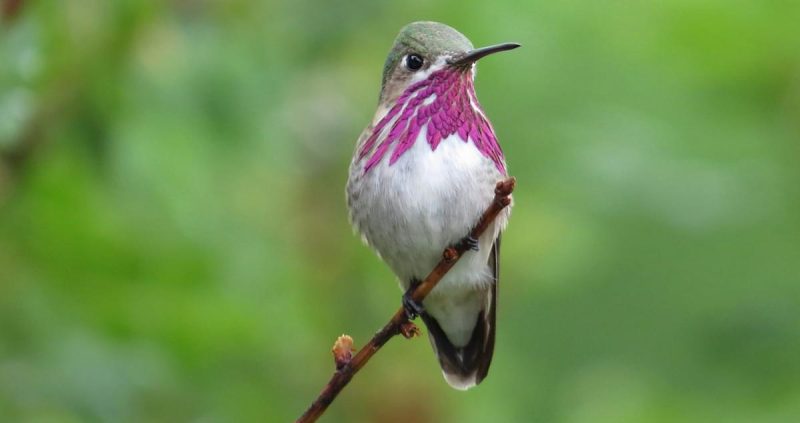
The Calliope Hummingbird holds the distinction of being the smallest bird in North America, measuring only about 3 inches in length and weighing less than a penny. Males are particularly striking, with long magenta streaks radiating across their throats, giving them a spiky, whiskered appearance. Females and juveniles are less colorful, with green backs and pale underparts, making them harder to distinguish from other small hummingbirds. Despite their delicate size, Calliopes are hardy and capable of incredible long-distance migrations.
Normally, Calliope Hummingbirds breed in the mountainous regions of the northwestern United States and migrate south into Mexico for winter. Their occurrence in Delaware is exceedingly rare, with only a handful of documented records. When they do appear, it is usually during migration misroutes or storms that push them far east of their expected path. Birdwatchers fortunate enough to spot one in Delaware often require photographic confirmation, as the species is both tiny and easily overlooked.
Feeding behavior is typical of hummingbirds, with Calliopes hovering at flowers and feeders to sip nectar. They also feed on insects, which provide critical protein for their high-energy lifestyles. In Delaware, feeders maintained into late autumn sometimes attract these wanderers, giving them a brief but crucial energy boost before continuing their unexpected journey. Despite their small size, they can be surprisingly aggressive, holding their own against larger hummingbird species when competing for food sources.
A fun fact about Calliope Hummingbirds is the remarkable distance they travel during migration. For such a tiny bird, their journey of over 5,000 miles round-trip is one of the longest migratory routes relative to body size of any bird in the world. When one turns up in Delaware, it represents an incredible detour from its normal path, making the sighting a once-in-a-lifetime event for many birders in the state.
Broad-tailed Hummingbird (Selasphorus platycercus)
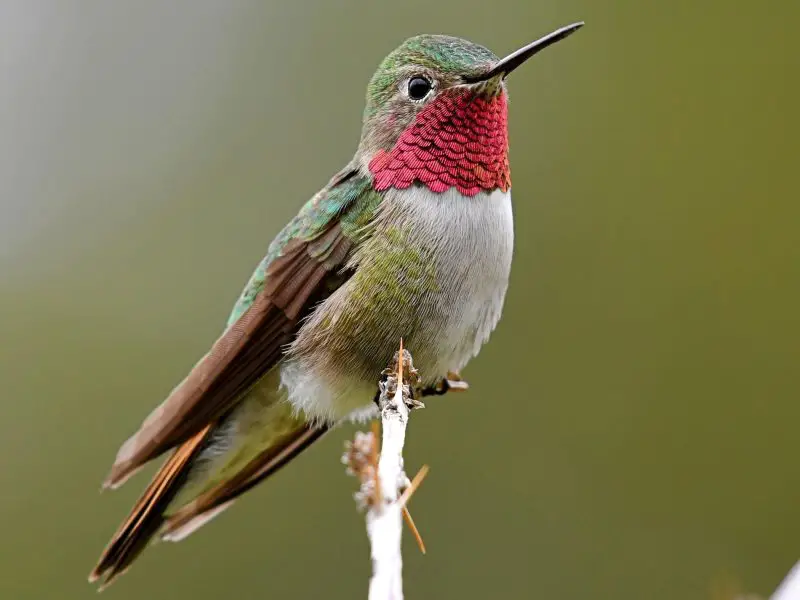
The Broad-tailed Hummingbird is another rare visitor to Delaware, normally inhabiting the western mountains of the United States. Adults measure about 3.75 to 4 inches in length, with males easily recognized by their brilliant rose-colored throats and metallic green backs. Females and juveniles are duller, showing green upperparts and buffy underparts with some spotting on the throat. One of the most distinctive features of this species is the trilling sound produced by the males’ wing feathers during flight, which can sometimes be heard before the bird is even seen.
In their usual breeding grounds, Broad-tailed Hummingbirds favor high-altitude meadows, open woodlands, and mountain valleys. Delaware sightings are extremely rare and typically result from long-distance wandering or storm-driven displacement. When they do appear, they are usually discovered in gardens or at hummingbird feeders where their unique throat coloration sets them apart. The last confirmed Delaware sighting dates back to the late 1990s, underscoring just how unusual it is to encounter this species in the state.
Broad-tailed Hummingbirds feed heavily on nectar-rich flowers such as penstemons and columbines, but they also catch small insects to meet protein needs. Their feeding behavior is similar to that of Ruby-throated Hummingbirds, though they are often more vocal, with males producing constant trills during territorial flights. In Delaware, they are most likely to appear during migration, when an individual strays far beyond its expected range in search of food or suitable resting habitat.
A fun fact about Broad-tailed Hummingbirds is their adaptation to cold environments. Unlike most hummingbirds, they are capable of entering torpor—a state of reduced metabolic activity—on cold mountain nights to conserve energy. If one appears in Delaware, this adaptation likely helps them survive sudden drops in temperature during unexpected stopovers. The idea of a hummingbird from the Rocky Mountains briefly visiting the mid-Atlantic is both astonishing and thrilling for local birdwatchers.
Best Time and Places to See Hummingbirds in Delaware
The best time to observe hummingbirds in Delaware is during the warm months, when migration brings both the common Ruby-throated Hummingbird and occasional rare visitors into the state. Ruby-throated Hummingbirds typically arrive in mid-April as spring begins, staying through the summer to breed and raise their young. By late September or early October, most have departed for their wintering grounds in Central America. During these months, Delaware birdwatchers have the highest chance of spotting hummingbirds in gardens, woodlands, and meadows filled with flowering plants. The peak activity often occurs in May and June, when males establish territories and females are busy nesting.
Fall is another rewarding time to watch hummingbirds in Delaware, as migration brings not only Ruby-throats but also rare western vagrants like Rufous, Black-chinned, and even Allen’s Hummingbirds. From late August through September, gardens and feeders become important stopover points for birds traveling long distances. Birders keeping nectar feeders filled during this time sometimes witness surprise visits from species not normally expected on the East Coast. The excitement of seeing a Rufous Hummingbird chasing away Ruby-throats or spotting a tiny Calliope at a backyard feeder makes autumn especially thrilling.
In terms of location, Delaware offers a mix of excellent habitats for hummingbird watching. Suburban gardens and yards planted with tubular flowers such as trumpet vine, bee balm, and cardinal flower are reliable places to attract Ruby-throats throughout the summer. State parks and nature preserves, including Bombay Hook National Wildlife Refuge and Cape Henlopen State Park, also provide excellent opportunities to see hummingbirds feeding among wildflowers or darting through forest edges. Along the coastal plain and river valleys, flowering shrubs and wetlands serve as natural magnets for migrating hummingbirds.
For the best experience, many birders recommend setting up feeders filled with a simple sugar-water solution from early spring until October. Feeders not only draw Ruby-throated Hummingbirds but also increase the chance of attracting rare visitors during migration. Early mornings and late afternoons tend to be the most active times, when hummingbirds feed heavily before the heat of the day or before roosting at night. By combining the right season, habitat, and patience, birdwatchers in Delaware can enjoy both the regular beauty of Ruby-throats and the excitement of encountering rare hummingbird species passing through the state.
FAQs About Hummingbirds in Delaware
What is the most common hummingbird in Delaware?
The Ruby-throated Hummingbird is the most common and the only species that regularly breeds in Delaware. It arrives in mid-April, nests throughout the summer, and departs by early October. Males can be identified by their shimmering red throat, while females lack the bright coloration. This species is the one most Delaware residents will see in gardens, parks, and nature preserves.
Do hummingbirds migrate through Delaware?
Yes, hummingbirds use Delaware as part of their migration route. Ruby-throated Hummingbirds migrate northward in spring to breed and return south in fall. During migration seasons, Delaware occasionally sees rare vagrant species such as Rufous, Black-chinned, Allen’s, and even Calliope Hummingbirds. These brief stopovers provide birdwatchers with rare opportunities to see species that normally belong to the western or southern United States.
When is the best time to see hummingbirds in Delaware?
The prime time for hummingbird watching in Delaware is from mid-April through September. Spring and early summer bring breeding Ruby-throats, while late summer and early fall are the best times to spot both Ruby-throats and rare migrating species. Early mornings and late afternoons are the most active feeding times, making them ideal for observation.
Where can I see hummingbirds in Delaware?
Hummingbirds can be seen across the state in both natural and suburban settings. Popular spots include Bombay Hook National Wildlife Refuge, Cape Henlopen State Park, and forested or meadow habitats with abundant wildflowers. Backyard gardens with tubular flowers such as trumpet vine, bee balm, and cardinal flower, as well as sugar-water feeders, also attract hummingbirds throughout the season.
Do hummingbirds stay in Delaware year-round?
No, hummingbirds do not remain in Delaware year-round. Ruby-throated Hummingbirds migrate south to Central America for the winter months, leaving the state by early October. Rare vagrant species may appear outside the normal migration period, sometimes as late as November or December, but these are unusual exceptions.
How can I attract hummingbirds to my backyard in Delaware?
To attract hummingbirds, Delaware residents can plant native tubular flowers that produce nectar, such as trumpet creeper, cardinal flower, and bee balm. Maintaining sugar-water feeders with the correct ratio of one part sugar to four parts water is another effective way. Feeders should be placed in shaded areas and cleaned regularly to prevent mold or bacteria. By combining natural flowers with feeders, homeowners create reliable food sources that hummingbirds return to throughout the season.

